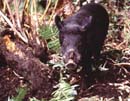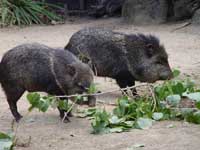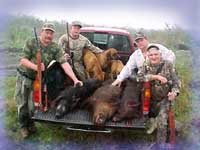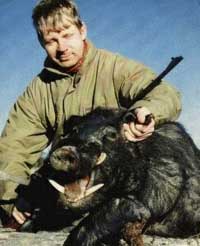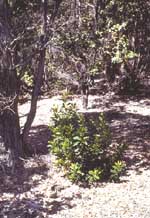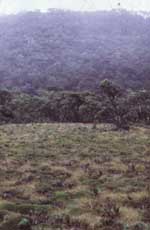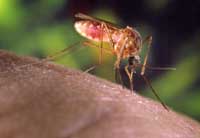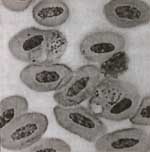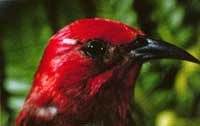| Threats to Hawaii's native species |
|
Wild Pigs and their effect on our bird population | |
Today's wild pigs probably descended from runaway domestic breeds in lowland areas. Perhaps aided by a seasonally abundant and expanding carbohydrate source-the invading nonindigenous strawberry guava-and by an enhanced protein source from abundant nonindigenous earthworms, truly feral pig populations developed and spread into adjacent pristine forests. European domestic pigs were among the earliest introduced species to arrive in Hawai`i. Without predators or herbivore competitors, these animals adapted well to life in the wet forest and rapidly established large feral populations. Their populations multiply unchecked, (a single pair and their offspring theoretically can produce 15,000 pigs in five years!). Feral pigs have endangered many of the native plant species by overgrazing in the rain forest. They churn up the forest floor in search of earthworms and fleshy plant roots and destroy vulnerable native plants such as mints and orchids. The starchy core of native tree ferns is also among the pigs' favorite foods. The pigs gnaw at the trees' bark and devour valuable nutrients from the forest floor. Opportunistic plant species, often nonindigenous, occupy the habitats remaining after feral pigs have eliminated native species. Seeds of nonindigenous plants are carried on pigs' coats or in their digestive tracts, and they thrive upon germination on the forest floor where pigs have exposed mineral soil. Once these aggressive plant invaders have obtained a new foothold in the forest, they spread aided by pigs and nonindigenous birds. | |
When you eliminate these feral animals, it doesn't make you popular. Some people would rather have the alien animals than the native plants. (The group that has come under the most criticism for its alien animal control program is The Nature Conservancy who used snares to trap pigs on Molokai, so animal-rights groups have accused the conservancy of being in-humane.) | |
| |
| An ecosystem is a balanced interaction of plants, animals and the environment in which they live. The balance is easily upset by "alien" interference. Look at how the alien pig is part of a chain of events that leads to disaster for native birds. | |
Earthworms are attracted to the roots of the plant. | |
The puddles provide a comfortable wallow for the pigs. | |
The mosquitoes lay their eggs there and the population grows. | |
Mosquitoes become parasite carriers once they bite an infected bird. They then spread the parasite and alien viruses to other birds in the same manner. | |
They develop avian malaria or bird pox, which shortens their lives and depletes their populations. |
|
|
|
Links Home Sanctuary Photos Oahu Amakihi Apapane Native Plants Ohia Lehua Acacia Koa Threats to Birds Alien Birds Field Reports Eco-Tours Birdwatching E-mail Us |
Phone:(808) 924-2473 Fax: (808) 924-5395 E-mail
